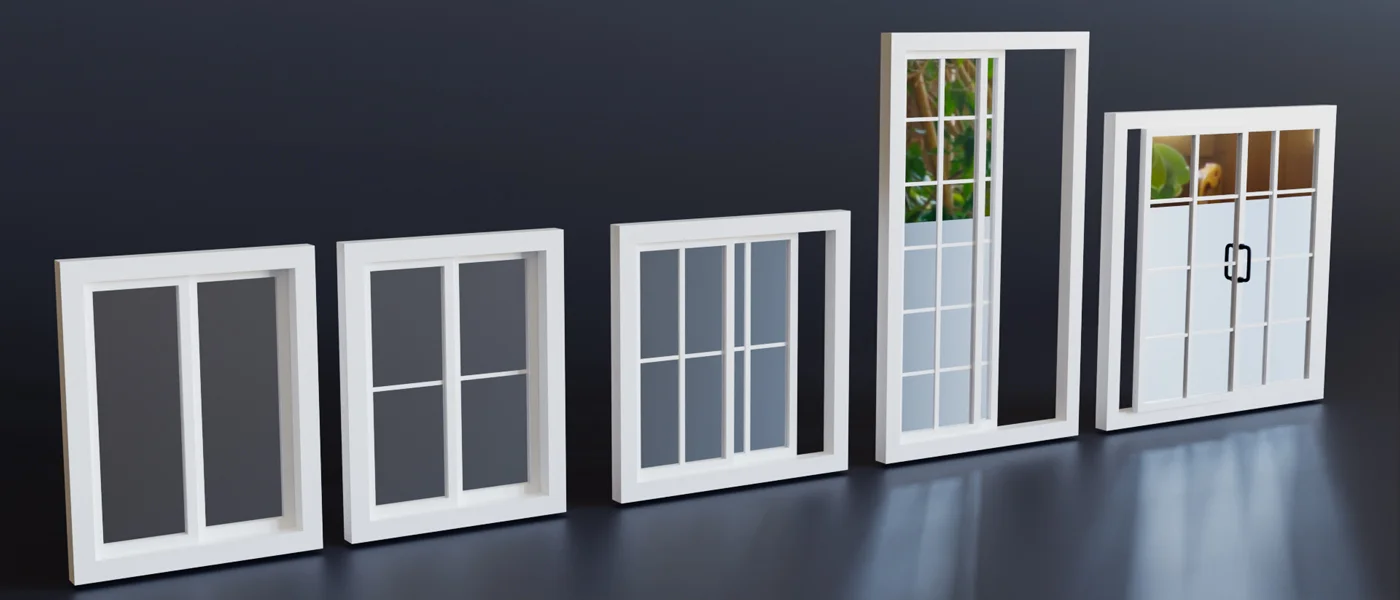Have you ever wondered which is the most suitable type of sliding window for you? This type of window has become a popular type in modern buildings due to its simple appearance, flexible operation and efficient space utilization. But what are the differences between different designs? This article will comprehensively analyze the different types, advantages and purchase suggestions.

Different Panels or Tracks of Sliding Windows
In fact, the number of panels or sashes corresponds to the number of window tracks. That is, modern sliding windows and doors with three tracks usually has three windows. The number of sashes of a sliding window directly affects its functionality and aesthetics. Common types include:
Single Panel sliding window
Only one sliding window is suitable for small spaces or scenes requiring local ventilation.
2 Panel sliding window
Usually two sashes can slide freely, or one is fixed and the other can slide. This type of window has a larger opening area and a ventilation rate of 100%.
3 Panel sliding window
The multi-sash design can achieve a larger window opening area, especially suitable for floor-to-ceiling windows or panoramic windows. Customers who choose multi-sash sliding windows usually pay less attention to space issues and need more lighting and ventilation convenience. It can be designed as a combination of 2 movable windows and 1 fixed window.
4 Panel sliding window
This type of sliding window requires a thicker wall because more layers of tracks are required. This window is suitable for creating a transparent panoramic view, such as floor-to-ceiling windows or glass curtain walls. Customers can use two movable and two fixed or all four movable sashes.

Comparison of Sliding Window Panels
| Types | Ventilation Area | Cost | Suitable Width | Recommended Application |
| Single Panel | 50% | Low | <1.2m | Family or areas with small window holes or low budget. |
| 2 Panel | 100% | Medium | 1.2-2m | Living room, bedroom, office and other conventional spaces |
| 3 Panel | 50%-100% | General | 2-3m | Larger windows or panoramic views. |
| 4 Panel | 100% | High | >3m | Villas, commercial spaces, floor-to-ceiling windows, etc. |
Different Frames of Sliding Windows
The frame material greatly affects the performance, price, service life, etc. of the window. As you can see, glass, tracks and other hardware are all built on the frame. Common materials include aluminum alloy, plastic steel, wood, composite materials, etc.
Aluminum Alloy Frame
The sliding aluminium windows frame is lighter and more corrosion-resistant. Its surface has been oxidized and can be sprayed in various colors. This is the material with the longest service life because of the excellent performance brought by its raw materials and good corrosion resistance. More importantly, its poor thermal insulation has been compensated by the broken bridge aluminum technology.
Plastic Steel Frame
UPVC is composed of PVC resin and internal steel lining. The thermal conductivity of this material is only 1/1250 of that of aluminum. As a result, it’s the first choice in cold areas. The price of this material is very cheap and the economic benefit is super high. Customers do not need frequent maintenance, which is suitable for families with high requirements for sound insulation and energy saving.
Wooden Frame
The wooden frame has a natural beautiful texture, and its sound insulation effect is very good. Moreover, the K value can be as low as 1.5W/(㎡·K)! This material has no other disadvantages except high maintenance costs. Therefore, it is recommended that customers regularly apply wood wax oil to wooden frames to achieve moisture-proof and insect-proof effects.
Other Composite Materials
A common composite material like aluminum clad wood composite window or wpc wood doors have good performance. Accordingly, it comes from outer layer of aluminum alloy and an inner layer of solid wood. There are advantages to the two materials. Aluminum-clad wood has strong adaptability and can be used for 45° angle transfer, wood grain transfer and other processes, which can achieve high-end customization effects.
Comparison of Materials
| Materials | Thermal Insulation | Sound Insulation | Weather resistance | Maintenance Costs | Styles |
| Aluminum | Medium | Medium | High | Low | Modern and industrial style |
| UPVC | High | High | High | Low | Simple and economical |
| Wood | High | High | Low | High | Nordic, pastoral, Chinese style |
| Aluminum Clad Wood | High | High | High | Medium | High-end, retro, natural style |
Different Glasses of Sliding Windows
The choice of glass directly affects the insulation, sound insulation and safety of sliding windows:
Single-layer glass
Single-layer glass is the most basic design, with a thickness of about 3-6 mm. It has the lowest price and does not require maintenance, but it has poor durability, is easy to break, and has strong sound and light penetration. Therefore, this type of glass is suitable for temporary buildings, low-budget projects, or areas with low performance requirements.
Double-layer glass
Generally, a PVB layer is added between the double-layer glass to achieve sound insulation and safety performance, or a hollow air layer is added to improve thermal insulation performance. Even if the glass is broken, the fragments of tall sliding windows will stick to the PVB film, effectively preventing splashing. So this glass is suitable for overpasses, near airports, and on the top of sun rooms.
Triple-layer glass
Common triple-layer glass includes 3 pieces of glass and 2 hollow air layers (such as 5mm+12A+5mm+12A+5mm), or combined with a laminated layer to enhance performance. When the air layer thickness is greater than 40mm, the sound insulation performance is significantly improved, which is suitable for cold areas or areas with high energy consumption requirements.
Low-E glass
Low-E glass refers to a metal film layer on the surface of the glass, which is often combined with hollow glass to achieve higher comprehensive performance. For example, Low-E coating + 12A+5mm glass. Low-E glass can reflect UV rays while introducing more light, because its visible light transmittance is greater than 80%. It is more suitable for high-rise buildings and tropical areas or modern designs that pursue high light transmittance and energy saving.

Comparison of Different Types of Glass
| Glass Types | Thermal Insulation | Sound Insulation | Safety | Light Transmittance | Cost |
| Single Layer | Low | Low | Low | High | Low |
| Double Layer | Medium | High | High | Medium | Medium |
| Triple Layer | High | Medium | High | Medium | High |
| Low-E Glass | High | Medium | Medium | High | High |
Different Directions of Sliding Windows
| Sliding Types | Direction | Tracks | Slashes | Application |
| Horizontal Sliding | left and right | Bottom or top | 2/3/4 | Larger windows (such as living rooms and balconies) |
| Vertical Sliding | up and down | Sides and top/bottom | 1/2 | Windows with high ceilings (such as study rooms and kitchens) |
Key Points of Choosing Different Sliding Windows
MapleMiles recommends that customers choose sashes, frames, glass types and operation methods based on budget, space size, architectural style and functional requirements (such as energy saving, safety, and sound insulation). Through this comprehensive analysis, customers can get bespoke sliding doors and windows can greatly improve living comfort!
Based on past cases, MapleMiles summarized several typical cases for your reference:
- Small urban apartment: choose double-leaf aluminum alloy sliding windows + double-layer glass to take into account both lighting and sound insulation.
- Villa or duplex: four-leaf wooden frame sliding windows + triple-layer glass can be customized to improve thermal insulation performance and aesthetics.
- Smart home: electric UPVC sliding windows + smart sensors to achieve automatic ventilation and safety protection.
Conclusion
If you have technical difficulties or are stuck in a dilemma, please contact MapleMiles team to get the most suitable customized solution!

